
Atlas F1 Senior Writer
With last month's Hungarian Grand Prix marking the 250th race of Honda's involvement in Formula One, Atlas F1's Thomas O'Keefe looks back at how the marque got to where it is today. He tells us how Honda initially became involved in Formula One, their attempts at being a supplier of engines and a constructor also, their successes (as well as their failures) and where they are headed in the future
Soichiro Honda and Bernie Ecclestone, two of the founding fathers of modern Formula One had one thing in common: both had overdone it in their youth as racers of cars and motorcycles, and having survived serious shunts in the All-Japan Speed Rally in Tokyo and at Brands Hatch respectively, turned to safer and more constructive ways to participate in motorsports. Both succeeded spectacularly to the benefit of all who love motorsports, one as an engine supplier to the sport and the other as a team owner of the Brabham Formula One team and promoter par excellence.
But Soichiro Honda (1906-91), based upon his experience as a driver, saw racing as an invaluable way for his engineers to learn their craft and viewed motorsports in all venues as a means to leverage Honda's products from the island of Japan to the rest of the world. Even today, the cream of the crop of Honda's young engineers are assigned to race engineering early in their careers, a tradition that is now an embedded part of the culture of Honda.
The Power of Dreams
Back in the summer of 1963 though, Mr. Honda and his company had more ambition than knowledge when it came to Grand Prix racing, so he went to the best resource he could find, Colin Chapman of Team Lotus, whose rear-engined cars were winning everything in sight, both on the road racing circuits of Europe and more recently even at the Indianapolis Motor Speedway, where Jim Clark and Dan Gurney had finished second and seventh at the 1963 Indy 500 in their Lotus-Fords in their first attempt to win The Greatest Spectacle in Racing.
Mr. Honda dispatched Honda's Chief Engineer Yoshio Nakamura, whom he had designated to head up Honda's Formula One project, to Europe in September 1963 on an exploratory mission to look for a Grand Prix chassis constructor with which Honda could partner. At the outset, Honda had no intention of coming into Formula One as a full-fledged constructor, which meant building both chassis and engine as Ferrari does but few others have throughout history of Formula One.
The Lotus 25 of Jim Clark had just won the 1963 Italian Grand Prix and Nakamura had preliminary discussions with Colin Chapman in Europe, which resulted two weeks later in Chapman coming to Japan to meet with Nakamura and Mr. Honda himself. At that meeting, the basic plan between the companies was outlined: the innovative 1.5 litre, transverse-mounted Honda V12 being designed in Japan would be installed in Jim Clark's Lotus for the 1964 season as Honda's way into Formula One. These were heady days for Chapman, who had just successfully completed an Anglo-American collaboration with Ford during 1962-63 and was now embarked on an Anglo-Japanese venture that would surely stretch the resources of Lotus at its smallish factory at Cheshunt in Hertfordshire, England.
Part I: Going It Alone
Less than a year from this meeting between Messrs. Honda and Chapman, a Honda would race in Formula One, but it would not be a Lotus-Honda. Incredibly, in January 1964, just after the last race of the 1963 Formula One World Championship season in East London, South Africa on December 28, 1963, Colin Chapman, having won both the World Constructors' and Drivers' Championships for 1963, changed his mind and cabled Honda that the deal was off. Needless to say Mr. Honda was not pleased. Necessity being the mother of invention, Honda had no alternative but to become a constructor and build its own car from the ground up - chassis, engine, the whole kit and caboodle.
With Chapman and Team Lotus not willing to be the midwife to bring Honda into Formula One, Honda searched elsewhere for inspiration in coming up the learning curve. A base of operations was established by Honda in Amsterdam, a port where it shipped in its motorcyles, which was also near the Zandvoort Grand Prix track for testing purposes, and Honda went to work to design and build a Grand Prix car for the 1964 season, which was scheduled to begin on May 10, 1964, at the Monaco Grand Prix.
As always, in the engine department Honda was on solid ground, its engineers being perfectly suited from their motorcycle engine training to produce a powerful engine from the small 1.5 litre maximum displacement that was to be the engine specification for Formula One from 1961-65. The engine ultimately produced by Honda was an absolutely beautiful piece of engineering and had all the bells and whistles racing fans treasure: a 60-degree V12 configuration, six twin-choke carburetors, four valves per cylinder actuated by twin overhead camshafts, with the engine designed to fit crosswise in the chassis. And what a sound the six twisty exhaust pipes produced: a shrill, ear-shattering blat blat revving at 10,000 rpm that sent everyone in its environs to their pockets for ear plugs.
With car development underway, Honda turned toward hiring a driver appropriate to the task at hand and again they acted against the grain and the conventional wisdom of the time and hired 28 year-old Ronnie Bucknum, an able but relatively unknown American sports car driver from California who had never even driven a single-seater!
But Bucknum was no slouch and had competed successfully for six years amidst the fierce West Coast SCCA sports car set that included future American Grand Prix drivers like Phil Hill, Dan Gurney and Richie Ginther. Running with a fast crowd, Bucknum had a number of wins in his sports car career and was famous for muscling a legendary crowd-pleasing Buick V8-powered mongrel called "Old Yeller" around West Coast racetracks, sometimes turning better times in Old Yeller than did Bucknum's better known predecessors in the car, which included Dan Gurney, who was by now driving Formula One cars. Later on in his career, Bucknum also showed he was a quick study in the Indy cars, winning only the second Indy car race he entered, the 1968 Michigan 500.
Though he was qualified, even Bucknum was surprised when he got the call from Mr. Okamoto of American Honda early in 1964, around the time of the Sebring 12-hour endurance race. Ronnie Bucknum's family did run a Honda dealership and Ronnie had experience racing the Honda S600 sports car, but he was far from the obvious choice. Nevertheless, Mr. Okamoto met Bucknum at a restaurant to explore the possibilities and before he knew it, Bucknum was on his way to Japan for a meeting with the 'higher ups' at Honda.
As Tim Considine describes the scene in American Grand Prix Racing, it must have been a dream come true for the lucky Bucknum to be greeted at the airport by Mr. Formula One at Honda: "at the [Tokyo] airport to meet Bucknum (who'd been given a Honda cap to wear so he could be recognized), was the man responsible for Honda's Formula One effort, Yoshio Nakamura." And so now all the pieces had fallen into place, as the bespectacled Japanese development engineer with a serious look on his face and a receding hairline left the Tokyo airport with the blonde crew-cut California with the Honda hat on; the two of them were destined to take the Honda marque to the great road racing circuits of Europe.
Located in the Eifel Mountains, the Nurburgring meandered through its 173 corners, throwing up a variety of challenges to both cars and drivers along the way, including bridges, hedge rows, long, narrow tree-lined straightaways and several areas where the cars became airborne! A perfect venue for Honda and its rookie driver to dip their toes into the fast running waters of Formula One. Exactly how new was this to everyone? Astoundingly, Bucknum attended his first Formula One race at Brands Hatch on July 11, 1964, where he watched the British Grand Prix along with Nakamura and Bucknum's wife, a race which Jim Clark won in his Lotus-Climax; 21 days later Ronnie Bucknum would be driving with Jim Clark in Formula One.
But for all the reasons to be apprehensive about this first race weekend, there happened to be a lot of American drivers in the Formula One paddock at that time, so Bucknum was among countrymen who had plenty of advice for him. Phil Hill was driving a Cooper-Climax for the Cooper works team, Peter Revson a Lotus-BRM for his own privateer "Revson Racing" team, Richie Ginther was a teammate of Graham Hill for the BRM factory tam, and Dan Gurney drove a Brabham-Climax along with owner Jack Brabham. Prior to qualifying, Gurney took Bucknum for a spin around the Nurburgring in a Mercedes road car to show him the ropes. Bucknum had also tried to familiarize himself with the incredibly long and complex track by driving round and round in a rented Volkswagen, with his wife as a passenger. She was knitting; he was memorizing.
During practice for the German Grand Prix at Nurburgring held on August 2, 1964, the Formula One community got its first look at what Japan hath wrought: an all-white car known as the RA271 with a distinctive bright red Rising Sun painted on the scuttle just ahead of the windscreen, powered by a deafening, high-revving, 1.5 litre V12 Honda engine that had a piercing exhaust note. The Honda ran on Dunlop tires initially before the team later switched to Goodyear tires.
As might be expected, the Honda RA271 that weekend in Germany had a cobbled-together look by comparison to the sleek green and yellow Lotus-Climaxes of Jim Clark and Mike Spence that had by now evolved from the Lotus 25 to the Lotus 33, the Brabham of Jack Brabham, the Ferraris of John Surtees and Lorenzo Bandini and the BRMs of Graham Hill and Richie Ginther. The two air scoops for cooling the Honda engine which were located on either side of Bucknum's head looked like they were made out of chicken wire from the local hardware store!
All things considered, it was a successful first outing at which the new kids on the block acquitted themselves well. Bucknum was placed 22nd and last on the grid after making five practice laps around the Nurburgring, the minimum requirement for the race organizers to permit rookie Bucknum to start. Just to add further to the team's apprehension, a 23rd car of Dutchman Carel Godin de Beaufort, a Porsche 718, did not start because of Beaufort's fatal crash during practice.
Honda skipped the next race at Austria to concentrate on development of a second RA271 chassis for the 1964 Italian Grand Prix at Monza, another high-speed track where the brute power of the now fuel-injected V12 (thought to be producing 220 bhp at 12,000 rpm) could show itself, with Bucknum qualifying tenth. Indeed, Bucknum had the thundering Honda up to fifth place before retiring after 12 laps due to overheating and brake problems. In due time, Honda engines would conquer the historic Monza track six times, but not this day.
The third and last race Honda entered in 1964 was the United States Grand Prix at Watkins Glen on October 4, 1964. The Rising Sun was still on its scuttle but a US flag emblem was on the Honda's flanks in recognition of Bucknum's nationality at his home race. During Sunday morning warm-up outside of the paddock garage on the top of the hill at Watkins Glen, the grey-uniformed Honda mechanics with "Honda Motors Tokyo" embroidered on the back of their shirts warmed-up the truly ear-splitting V12 outside the garage (possibly at the request of the other teams working inside the garage) in a fenced enclosure much to the delight of the small coterie of early-risers that had sleepily wandered over from their infield camp sites. Notwithstanding the noisy prologue, the race for Bucknum came to a quiet end when the Honda succumbed to a blown cylinder head gasket and overheated after 50 laps and 115 or so miles, which was still the longest Honda's new car had run to date.
The Ginther Era
In the 1965 season, the far more experienced fellow Californian Richie Ginther, ex-Ferrari, ex-BRM, joined Bucknum at Honda and the two of them campaigned the updated RA272 (now rated at 240 bhp and 11,000 rpm) from the home base in Amsterdam in a rollercoaster of a year that saw the team qualify as anchormen at the tail of the grid at Monaco on May 30, 1965, and yet achieve Honda's first Formula One win in Mexico City on October 24, 1965, with Ginther in first place leading flag to flag, Bucknum finishing fifth. Remember, Honda had only won its first points at a rainy and diabolical Spa earlier that season when Ginther qualified fourth and finished sixth, so the significance of winning in Mexico only four months later cannot be overstated. By comparison, in 1998, we marveled at Eddie Jordan achieving Jordan's maiden win at Spa, after over seven years in Formula One.
Honda had brought itself from obscurity to a win in less than 15 months. Interestingly, the success of the Japanese/American Honda effort that culminated in the Mexico City victory also meant success for Akron, Ohio-based Goodyear, for whom the 1965 Mexican Grand Prix was also its first Formula One win. An ironic footnote to the historic Honda victory at Mexico City is that the two drivers had switched cars after qualifying (Ginther had qualified third and Bucknum tenth) and Ginther, in effect, won in Bucknum's car.
With the introduction in 1966 of the 3 litre formula, Honda had to go back to the drawing board and was unable to capitalize immediately on the success it enjoyed at Mexico City in its 1.5 litre car in the last race of the 1965 season, and the last race for that formula. Honda delayed the debut of its 3 litre RA273 V12, which produced 380 bhp, until the Italian Grand Prix at Monza in September 1966, and competed only in the last three races of the year. At Monza, Ginther fell victim to a tire going down and crashed at the Curva Grande at speed. At Watkins Glen, Ginther led the first two laps but fell back and finished in fourth place. Overall, the 1966 season was without notable success in the powerful but heavy 3 litre car, Ginther doing his best again in high-altitude Mexico (where Honda's fuel injection system was an advantage), qualifying third and leading the first two laps but finishing in fourth place, the best result of the season.
The 1966 Mexican Grand Prix was the last race for Ginther and Bucknum as Honda drivers; Ginther would go on to join Dan Gurney's All-American Racers and participate in two non-Championship races but he retired on the spot after failing to qualify the Eagle for the 1967 Monaco Grand Prix. Bucknum never again drove in a Grand Prix.
The Surtees Era
For 1967, Honda returned to its roots and threw its lot in with John Surtees, a fellow motorcycle racer and champion who remains the only driver to have won World Championships on both two wheels and four wheels, having become a Formula One Champion with Ferrari in 1964 after having been a multiple motorcycle champion before coming to Formula One.
For the 1968 season, there were actually two entirely different looking cars designed by Honda - the V12 RA301 and the air-cooled V8 RA302 - with four drivers driving for Honda that year at one time or another - John Surtees, Jo Bonnier (1 race), David Hobbs (1 race) and Jo Schlesser (1 race) - but usually only one car was run at a Grand Prix, except at the venues where the Honda tended to race well, such as Monza and Mexico City.
In Formula One generally, there was an ill wind blowing in 1968 and Honda's season reflected that experience. On April 7, 1968, Jim Clark, two-time World Champion and Indianapolis 500 winner, was killed in a Formula 2 race at Hockenheim, Germany. On May 7, 1968, Mike Spence of Team Lotus was killed during practice for Indianapolis in the STP Lotus 56 turbine car. On May 12, 1968, only 13 cars managed to start the Spanish Grand Prix at Jarama, a new low. On May 26, 1968, no Ferraris were entered at the Monaco Grand Prix because of the death of Ferrari Driver Lorenzo Bandini at the 1967 race and the subsequently adopted safety requirements that were in effect for 1968 which Ferrari did not agree with.
Honda's 1968 season began with the old Monza-winning 1967 'Hondola' RA300 which was used for the South African Grand Prix at Kyalami on January 1, 1968, but by the time of the Spanish Grand Prix at Jarama on May 12, 1968, the new lightweight aluminum-bodied RA301 that was on the drawing boards was entered by "Honda Racing", but the chassis/engine combination was still heavier than the winning RA300 from the year before. Surtees and his engineering staff were constantly engaged in a 'Battle of the Bulge' to somehow harness the powerful but heavy Honda V12 engines to produce a car whose performance lived up to the horsepower ratings, claimed to be 420 bhp at 10,000 rpm for the RA301, but probably closer to an effective 380 bhp. The new car turned in some indifferent outings, suffering gearbox failures at Spain and Monaco, and although the powerful V12 helped out on the long straights at Spa, Surtees retired there with suspension failure after qualifying fourth and setting fastest lap. At Zandvoort, the alternator failed.
On July 7, 1968, the French Grand Prix was scheduled, and the events that transpired there sealed both Honda's fate for the 1968 season and its departure from Formula One as a constructor. Soichiro Honda himself, then 62 years of age, always focused on advancing technology through racing, and was determined that Honda develop an air-cooled Formula One engine. While Surtees was running the V12 RA201 at the 1968 races, Honda was simultaneously developing an air-cooled V8 RA302 in Japan, with a magnesium chassis designed around it, that was being readied for racing by mid-season.
In qualifying, the V12 RA301 driven by Surtees was seventh, while Schlesser in the new V8 RA302 could only manage seventeenth, next to last. Surtees' intuition about the RA302 seemed to be confirmed. It was raining when the French Grand Prix started and it has been speculated that rain may have gotten into Schlesser's exposed air-cooled V8 engine and its electrical system, causing the engine to misfire and cut out, which led to Schlesser losing control of the RA302 during lap three of the race at the curve before the run down to the Nouveau Monde hairpin. The car climbed an embankment and somersaulted, exploding in a blaze of fire with tanks full of fuel on board since it was so early in the race. The highly flammable magnesium alloy, of which much of the car was made, led to a huge fireball in which Schlesser was killed. He had raced 13 kilometers.
Surtees continued, despite Schlesser's accident; you can imagine the thoughts of John Surtees as he circulated lap after lap past the smoldering wreckage of his teammate's RA302 and the plume of smoke left behind. Surtees soldiered on and ironically finished second in the RA301, which was Honda's best finish in the 1968 season. Although the team finished out the season, with David Hobbs and Jo Bonnier driving one-offs, the Honda Formula One constructor project, Part I, ended that day at Rouen with the death of Jo Schlesser and so in November 1968, after the last race of the 1968 season in Mexico City, Honda formally withdrew from Formula One.
In that last race in Mexico, Jo Bonnier had qualified poorly but finished in the points in fifth place, while John Surtees had just the reverse experience, qualifying in sixth but retiring from the race with overheating problems. And so it ended.
Part II: Honda Returns to Formula One As An Engine Supplier
Plainly, the tragic events of 1968 and the generally unsuccessful nature of its last season in Formula One left a bad taste in the mouth of Honda, which turned back to its core business - manufacturing and selling road cars - turning in spectacular results.
By October 1983, however, Honda had decided that the longer-established team run by Frank Williams would be a better development partner and switched their engines from Spirit to Williams, which had been using Ford engines to that point. The switch to Williams was vindicated on July 8, 1984 on the sweltering streets of Dallas, Texas, when Keke Rosberg's Williams-Honda won the 1984 U.S. Grand Prix, Honda's first win in Formula One since the thrilling victory by John Surtees in the 'Hondola' at Monza in 1967.
It should be noted that the decision to go with Williams over Spirit was a very similar decision to that made by Honda 20 years later in 2003, when Honda had been supplying Honda V10s in Formula One to both Jordan and BAR for the 2002 season: Honda decided to drop the Jordan team as a customer, deciding to focus all its efforts on one Honda-supplied team, BAR-Honda. It decided in 1983 and again in 2003 that supplying two teams was only diluting the quality of Honda's development work on the engine. On both occasions, Honda protected its customers in an honorable way. In the case of Spirit Racing in 1983, a Hart engine was arranged; in the case of Jordan in 2003, a Ford-Cosworth engine was the engine option taken up by Eddie Jordan, reportedly with assistance from Honda.
Back in 1983, Honda focusing on Williams turned out to be the right choice. Within two years, Honda was fully back in the swing in Formula One, supplying the winning engine to Williams in the Williams-Honda Championship years of 1986 and 1987 and supplying McLaren its powerplant in the McLaren-Honda Championship years of 1988, 1989, 1990 and 1991, six consecutive years of having the best engines in Formula One. During the McLaren period, it is thought that Ayrton Senna's close relationship with his Honda mechanics was a substantial contributor to the domination of Formula One demonstrated by Honda during the 1988-91 era; according to Senna's teammate during much of that period, Alain Prost, the Honda mechanics regarded Senna as a "samurai" and Prost as a "computer", and Senna was the one who benefitted from those perceptions, real or imagined.
In September 1992, Honda announced it would be withdrawing from Formula One at the end of the 1992 Formula One season. Appropriately, a McLaren-Honda driven by Senna's teammate, Gerhard Berger, won the last race, the Australian Grand Prix in Adelaide in November 1992. So ended Honda's second foray into Formula One, which had lasted nine years, this time establishing itself beyond the shadow of a doubt as the company that built the best high-performance engines in the world.
Part III: Will Honda Build The Whole Thing, Again?
Having proved so much, so conclusively and for so long, Honda stayed out of Formula One until the late 1990s, when the major automobile manufacturers began to re-enter the sport. Then came the next iteration of Honda's on-again, off-again, relationship with Formula One. During the week leading up to the Japanese Grand Prix at Suzuka on November 1, 1998, Honda's then-President Hiroyaki Yoshino announced at a luncheon for motor racing journalists that Honda would be returning to Formula One, this time as a constructor, and that two prototypes were being developed with Dallara under the overall direction of Harvey Postlethwaite, a brilliant British designer who had produced many successful Formula One chassis for a variety of constructors, including March, Hesketh, Wolf, Tyrrell, Ferrari and now Honda. Mr. Yoshino explained the rationale for the decision as follows: "Some see [Formula One] as only risky and expensive. I deeply believe our experience in racing competition is a basic reason for Honda's success. From that pressure comes progress and it also speeds up decision-making. The real bottom line of racing is that it challenges our engineers."
What have been the results of the BAR-Honda collaboration thus far? In a word, disappointing: two podium finishes in the 2001 Spanish and German Grands Prix is the sum total. During the 2000-2002 seasons, both BAR and Jordan have been subjected to an alarming number of spectacular engine detonations, not the Honda Way, but at least it shows that the engineers are trying. During the 2003 season, however, with Honda able to focus only on BAR, better results are beginning to come in, both in qualifying and in races, with the whole team benefitting from the strong competition between BAR-Honda's drivers, Jacques Villeneuve and Jenson Button. It is not uncommon for Honda to try a "step" engine during weekend practice and then run a more reliable specification in the race as the "step" engine continues to be developed for use as race engine two weeks or a month hence. In time, Honda will produce a more consistent engine product.
To quote Honda F1's project leader, Takeo Kiuchi: "Over the past three years we have had a difficult time since our return to F1 - we have not been satisfied with our performance and we want to do better. In 2003 we want to start the season competitively. The RA003E is more than 15kg lighter than last year's engine, it revs to more than 19,000 rpm and the torque curve is improved, too. Our target is to get into a position to fight for the world title as soon as possible. In short, Honda is committed to BAR, to Formula One and to winning." On another occasion, Kiuchi has been unusually candid in saying that "our objective is to reach 900 horsepower as soon as possible."
Most recently, Honda has also committed itself to another challenge: winning the Indianapolis 500, something it has never achieved, though victory was snatched away by the narrowest of margins in the 1995 Indy 500. Prior to the 2003 season of the Indy Racing League, Honda announced that its racing subsidiary, Honda Performance Development, in partnership with Ilmor, would build an IRL-spec 3.5 litre engine called the Indy Honda V8; at the Indy 500 this year, Japanese engines from Toyota and Honda outnumbered the Chevy V8s, with the Toyota-powered Penske team winning the 2003 Indy 500, placing first and second, with Brazilian Tony Kanaan's Honda-engined Dallara finishing third the best-placed Honda. Thus, the Indianapolis 500 remains on the list of challenges for Honda.
Just how close did Honda come to winning the Indy 500 in its best prior attempt in 1995? Honda had only two cars in the field for the 1995 Indy 500, but one was the LCI/Motorola/CNN Reynard-Honda driven by Scott Goodyear, who had qualified the Honda-engined car on the outside of the front row. Goodyear, now a TV commentator for the Indy 500, recalled at this year's Indy 500 what it was like to watch the Honda engineers in action:
"So I come down and I walk down the lower part of the trailer and there are still some more people there with the computers, but then we went behind a little pocket door into the very back of the trailer, which I had never been to even as I started with them back in April, and there had been four engineers there watching the telemetry and watching the computers live as I am out there running, and I had never met these guys before. They must get there at six in the morning. When you leave at night, they are still there. And I walked in there, and I thought, "This is just another level of commitment that is here with these guys." And I am sure it has grown since then.
The drive and the commitment from the Japanese manufacturers was overwhelming for me at that point in time, and Chevrolet and Ford were involved in the series at that moment, and I could see why they were getting success. And I guess I am not surprised to sort of see both Toyota and Honda come in this year and make a mark so quickly. And they really want to out-do each other. We talked about that on the Japanese telecast, and I think that they will stop at nothing. And I am sure that both of them are trying to win this event for the first time as we thought we had done for [Honda] in '95. There is no doubt they are going to pull out all the stops, and they have probably been preparing for this one race. It is probably more important than the whole season to them. It is more important than the first IRL win. It is the Indy 500."
In the 1995 Indy 500 race, Goodyear's Reynard-Honda, which had qualified on the front row, was in the hunt towards the end, and by lap 190 was in the lead as the green flag was given for a restart. Unfortunately, Goodyear was so anxious to get out in front that he passed the pace car before it got off the track. Because of the ensuing black flag for passing the pace car, the victory went to Jacques Villeneuve in his Reynard-Ford Cosworth and Honda found itself deprived of victory in the big race, through no fault of the engine. Ironically, Jacques Villeneuve, who had the good fortune to beat Honda back at the 1995 Indy 500, is now the senior driver on the BAR-Honda team and his win at the 1995 Indy 500 was the critical element that vaulted him into Formula One, joining the Williams team and now BAR-Honda.
BAR is owned by British American Tobacco, which along with Marlboro, Benson & Hedges, the Japanese cigarette Mild Seven and other tobacco companies are core sponsors of Formula One and have been since 1968 when Team Lotus first brought Gold Leaf tobacco sponsorship into the sport. But when the prohibition on tobacco advertising in European Union countries becomes effective in July 2005 and tobacco sponsorship of a team no longer serves a commercial advertising purpose, it would seem a logical time for Honda to acquire the BAR team outright from British American Tobacco, and re-christen it "Honda", much as Benetton over two years transformed itself into Renault F1. Once that step is taken, Honda can finally get about the business of frontally taking on the other manufacturers in Formula One - Fiat (through Ferrari), BMW (through Williams), Renault, Mercedes-Benz and DaimlerChrysler (through McLaren), Ford (through Jaguar) and Honda's chief domestic competitor Toyota - with the full might of its own factory.
It is Honda's competition with Toyota and Renault that may be the decisive factor in pushing Honda to a full factory commitment to Formula One. Toyota is a larger company than Honda and continues to press that advantage, and Renault and Japanese manufacturer Nissan have a strategic alliance in place to strengthen their positions as competitors of Honda worldwide for the same customer base. Indeed, it is becoming apparent that Formula One has become the Superbowl of Motorsports for the major manufacturers, a proxy for the competition of the marketplace where these companies face each other day after day in showroom dealerships all over the world. With Renault, Toyota, BMW, Ford and DaimlerChrysler investing hundreds of millions in promoting their products through Formula One, can Honda be far behind?
One final sign of the depth and breadth of Honda's commitment to Formula One is the replacement of Hiroyuki Yoshino (who announced somewhat prematurely Honda's return to Formula One as a constructor in 1998) with Takeo Fukui, 58 years old, as President of Honda. Unlike Mr. Yoshino, Mr. Fukui was a race engineer, and Mr. Fukui is currently a Senior Managing Director of Honda, whose responsibilities include being in charge of the Honda Formula One project and Fukui clearly has the instincts of a racer. He knew founder Soichiro Honda and has been quoted as saying that he joined Honda as a young engineer "because it was the only company in Japan that had Formula One racing."
It sounds then like Honda is in good hands.
Prologue
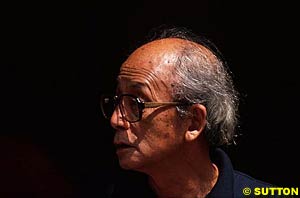 But though we tend to think today of Honda Motor Company, Ltd. as one of the world's great automotive manufacturers, when Honda first entered Formula One racing 40 years ago in 1963 the company was far from the automotive powerhouse it has become today. Indeed, Honda had only recently begun building smallish sport cars called the Honda S600 and S800 aimed at the American market, Honda's tradition being that of a company that built small trucks and motorcycles, the latter continuing to be one of the Honda's hallmarks.
But though we tend to think today of Honda Motor Company, Ltd. as one of the world's great automotive manufacturers, when Honda first entered Formula One racing 40 years ago in 1963 the company was far from the automotive powerhouse it has become today. Indeed, Honda had only recently begun building smallish sport cars called the Honda S600 and S800 aimed at the American market, Honda's tradition being that of a company that built small trucks and motorcycles, the latter continuing to be one of the Honda's hallmarks.
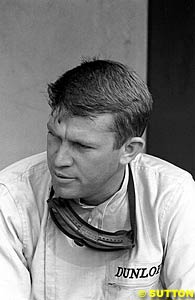 The chassis was the aspect of the car where Honda needed a template. Honda Research and Development had acquired a rear-engined 1961 Cooper-Climax T53 for reverse engineering purposes, and used the layout of that car to create a gold-colored spaceframe prototype called the Honda RA270F, which in turn evolved into the RA271-1, the first bona fide Formula One car ever built by Honda. The RA271-1 was painted white and had a nose that looked something like a Lotus 25, as well as a monocoque chassis. But there the resemblance to the elegant Lotus ended, as a somewhat ungainly-looking slab-sided body gave way to a bulky engine bay, which had to be wider than in the usual 1.5 litre Grand Prix car to accommodate all those cylinders, carburetors and exhaust pipes sprouting from behind the cockpit and sitting transversely over the rear axle. Even the powertrain was novel, as power from the high-revving V12 came from the center of the crankshaft given the location of the engine, delivering about 220 bhp directly into a six-speed transaxle.
The chassis was the aspect of the car where Honda needed a template. Honda Research and Development had acquired a rear-engined 1961 Cooper-Climax T53 for reverse engineering purposes, and used the layout of that car to create a gold-colored spaceframe prototype called the Honda RA270F, which in turn evolved into the RA271-1, the first bona fide Formula One car ever built by Honda. The RA271-1 was painted white and had a nose that looked something like a Lotus 25, as well as a monocoque chassis. But there the resemblance to the elegant Lotus ended, as a somewhat ungainly-looking slab-sided body gave way to a bulky engine bay, which had to be wider than in the usual 1.5 litre Grand Prix car to accommodate all those cylinders, carburetors and exhaust pipes sprouting from behind the cockpit and sitting transversely over the rear axle. Even the powertrain was novel, as power from the high-revving V12 came from the center of the crankshaft given the location of the engine, delivering about 220 bhp directly into a six-speed transaxle.
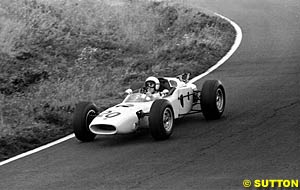 This unlikely duo of Nakamura and Bucknum had their baptism of fire under the most difficult of circumstances, which only compounded the inexperience of both the driver and the official entrant of the car, "Honda R & D." As delays in the completion of the RA271 played out, the first race in 1964 that Honda could enter was the German Grand Prix, to be held on the fearsome 14.17 mile Nurburgring circuit, a dangerous racetrack which had claimed many lives over the years. The track was so long, it took a Grand Prix car nearly nine minutes to complete a lap; by comparison, today's Grand Prix cars complete a lap in approximately one and a quarter minutes.
This unlikely duo of Nakamura and Bucknum had their baptism of fire under the most difficult of circumstances, which only compounded the inexperience of both the driver and the official entrant of the car, "Honda R & D." As delays in the completion of the RA271 played out, the first race in 1964 that Honda could enter was the German Grand Prix, to be held on the fearsome 14.17 mile Nurburgring circuit, a dangerous racetrack which had claimed many lives over the years. The track was so long, it took a Grand Prix car nearly nine minutes to complete a lap; by comparison, today's Grand Prix cars complete a lap in approximately one and a quarter minutes.
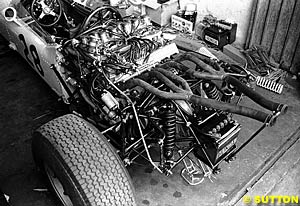 Remarkably, in a 15 lap race won by the Ferrari of John Surtees, Bucknum managed to last as long as Jack Brabham's Brabham at 11 laps until Bucknum spun at a corner with four laps to go for reasons that are thought to have been due to metal fatigue in the steering apparatus, not to Bucknum's driving. Even so, Bucknum's Honda finished ahead of a long list of distinguished non-finishers: Clark's Lotus 33, Bruce McLaren and Phil Hill in their Coopers and Peter Revson and Mike Hailwood in Lotus-BRMs, to name a few.
Remarkably, in a 15 lap race won by the Ferrari of John Surtees, Bucknum managed to last as long as Jack Brabham's Brabham at 11 laps until Bucknum spun at a corner with four laps to go for reasons that are thought to have been due to metal fatigue in the steering apparatus, not to Bucknum's driving. Even so, Bucknum's Honda finished ahead of a long list of distinguished non-finishers: Clark's Lotus 33, Bruce McLaren and Phil Hill in their Coopers and Peter Revson and Mike Hailwood in Lotus-BRMs, to name a few.
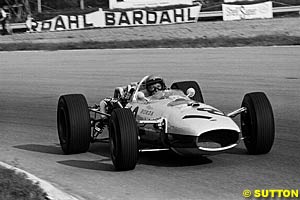 Honda had other notable outings in 1965. At Silverstone, Ginther qualified the RA272 in third and led briefly before going out with ignition trouble. At Zandvoort, Ginther led again after qualifying third, and after two spins, hung on to finish in sixth place. At Monza, Bucknum qualified sixth but developed engine trouble and at Watkins Glen, Ginther qualified third but spun on lap one and finished in seventh place.
Honda had other notable outings in 1965. At Silverstone, Ginther qualified the RA272 in third and led briefly before going out with ignition trouble. At Zandvoort, Ginther led again after qualifying third, and after two spins, hung on to finish in sixth place. At Monza, Bucknum qualified sixth but developed engine trouble and at Watkins Glen, Ginther qualified third but spun on lap one and finished in seventh place.
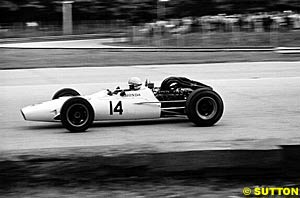 Honda and its top engineering staff was focused on meeting the demands for production of its road cars and, in effect, the 1967 and 1968 seasons were sub-contracted to John Surtees, who ran Honda Racing from Slough, England and who threw everything he (and Lola) had at the project to deliver a winning car, and achieved a stunning second Honda Formula One victory in 1967 at Monza. In a thrilling finish, Surtees just edged out Jack Brabham's Brabham by two tenths of a second in a hybrid car that was developed based upon the design of Lola's Type 190 Indianapolis car and was dubbed the 'Hondola' but officially designated the RA300/1. As in Honda's 1965 win in Mexico City, the 1967 Honda win at Monza was truly remarkable as it was the RA300's very first race and the car itself was built in just six weeks. However, Surtees' triumph was Honda's last victory in Formula One as a constructor.
Honda and its top engineering staff was focused on meeting the demands for production of its road cars and, in effect, the 1967 and 1968 seasons were sub-contracted to John Surtees, who ran Honda Racing from Slough, England and who threw everything he (and Lola) had at the project to deliver a winning car, and achieved a stunning second Honda Formula One victory in 1967 at Monza. In a thrilling finish, Surtees just edged out Jack Brabham's Brabham by two tenths of a second in a hybrid car that was developed based upon the design of Lola's Type 190 Indianapolis car and was dubbed the 'Hondola' but officially designated the RA300/1. As in Honda's 1965 win in Mexico City, the 1967 Honda win at Monza was truly remarkable as it was the RA300's very first race and the car itself was built in just six weeks. However, Surtees' triumph was Honda's last victory in Formula One as a constructor.
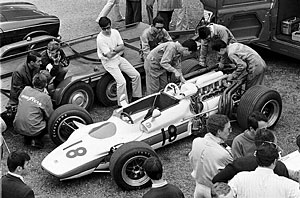 Just before the French Grand Prix, Surtees tested the new air-cooled RA302 at Silverstone and pronounced it "not ready" to race. Surtees was known to be honest and brutally frank with his superiors and had quit Ferrari in 1966 after a disagreement with Enzo Ferrari. The political problem was that Soichiro Honda was in France on a trade mission at the time and wanted to see the RA302 introduced at the French Grand Prix. A compromise was agreed upon: Surtees opted to drive the RA301 entered by "Honda Racing", and Jo Schlesser, a popular French sports car endurance driver, was entered by "Honda Racing (France)" to drive the new RA302 V8. Schlesser had just turned forty years old but had raced in only two Grands Prix, and in those he had raced Matra-Ford Formula 2 cars. Racing for the prestigious Japanese company at the magnificent Rouen circuit, with its fast flowing high speed corners set out in the French countryside amongst rolling hills and embankments, was clearly going to be a high point of Schlesser's career.
Just before the French Grand Prix, Surtees tested the new air-cooled RA302 at Silverstone and pronounced it "not ready" to race. Surtees was known to be honest and brutally frank with his superiors and had quit Ferrari in 1966 after a disagreement with Enzo Ferrari. The political problem was that Soichiro Honda was in France on a trade mission at the time and wanted to see the RA302 introduced at the French Grand Prix. A compromise was agreed upon: Surtees opted to drive the RA301 entered by "Honda Racing", and Jo Schlesser, a popular French sports car endurance driver, was entered by "Honda Racing (France)" to drive the new RA302 V8. Schlesser had just turned forty years old but had raced in only two Grands Prix, and in those he had raced Matra-Ford Formula 2 cars. Racing for the prestigious Japanese company at the magnificent Rouen circuit, with its fast flowing high speed corners set out in the French countryside amongst rolling hills and embankments, was clearly going to be a high point of Schlesser's career.
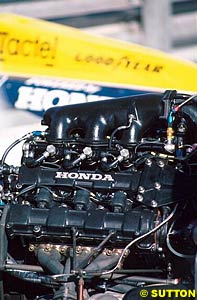 But Honda did keep its hand on the pulse of open-wheel racing by developing successful Formula 2 engines used by other constructors. In March 1983, at the Geneva Motor Show, Honda displayed a 1.5 litre V6 turbo built to Formula One specifications, an indication of its interest in rejoining the fray. In the early part of the 1983 season, Honda agreed to supply its V6 turbo to Spirit Racing, one of its Formula 2 customers. Spirit and Honda in effect were of mutual use to one another, Honda using Spirit's driver Stefan Johansson and the Spirit 201 car as its development team to assess its re-entry into Formula One, and Spirit having entree to Formula One and access to a better engine than it could have otherwise afforded.
But Honda did keep its hand on the pulse of open-wheel racing by developing successful Formula 2 engines used by other constructors. In March 1983, at the Geneva Motor Show, Honda displayed a 1.5 litre V6 turbo built to Formula One specifications, an indication of its interest in rejoining the fray. In the early part of the 1983 season, Honda agreed to supply its V6 turbo to Spirit Racing, one of its Formula 2 customers. Spirit and Honda in effect were of mutual use to one another, Honda using Spirit's driver Stefan Johansson and the Spirit 201 car as its development team to assess its re-entry into Formula One, and Spirit having entree to Formula One and access to a better engine than it could have otherwise afforded.
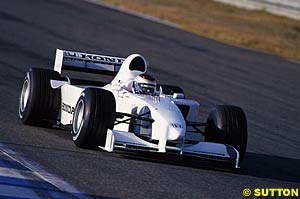 But this second attempt by Honda to become a Formula One constructor was stillborn when Dr. Postlethwaite died in April 1999 during a Honda test session in Barcelona. A month later on May 21, 1999, Honda and British American Racing announced that beginning in the year 2000, Honda would supply engines to BAR, and Honda would formally abandon, at least for a time, the program of returning to Formula One as a constructor.
But this second attempt by Honda to become a Formula One constructor was stillborn when Dr. Postlethwaite died in April 1999 during a Honda test session in Barcelona. A month later on May 21, 1999, Honda and British American Racing announced that beginning in the year 2000, Honda would supply engines to BAR, and Honda would formally abandon, at least for a time, the program of returning to Formula One as a constructor.
"And I thought that I really understood everything the [the Honda mechanics] were doing, the dedication they seem to have and how they were single-minded toward the "500". But as I started to do some testing after the [1995 Indy 500], I can recall a time at Mid-Ohio, probably in August, getting ready for the event there in September. We had been there for a couple of days testing, and we were trying to improve the car, improve the motor, and I went into the Honda trailer like I had done so many times before and sat in the front lounge with the engineers. We went over some things and were really trying to pinpoint one thing that was happening on the racetrack and they said: "you know, for this we must go back and look at some data. And can you come with us?"
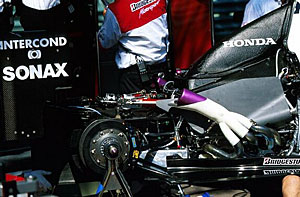 Turning back to Formula One, it must be asked that for all of the talk of collaboration between Honda and its chassis partner BAR, there are many in the world of Formula One who assume that BAR will ultimately become at long last the Honda Factory Team that Soichiro Honda envisioned 40 years ago. In the most recent Honda press releases there is reference to Honda not only supplying engines but continuing "to play a role in the joint chassis development program." And BAR's new technical director Geoff Willis describes the current arrangement as follows: "[We are] a lot happier with the situation at BAR now. We've had a year to rebuild the team, sort out the engineering, sort out the management of the team. There's been quite a big change also with our engine partner in the engineers working on both the engine and some of the chassis projects and the whole thing seems to be coming together much better, so, there's still a lot of work to do but we've now established a good base point."
Turning back to Formula One, it must be asked that for all of the talk of collaboration between Honda and its chassis partner BAR, there are many in the world of Formula One who assume that BAR will ultimately become at long last the Honda Factory Team that Soichiro Honda envisioned 40 years ago. In the most recent Honda press releases there is reference to Honda not only supplying engines but continuing "to play a role in the joint chassis development program." And BAR's new technical director Geoff Willis describes the current arrangement as follows: "[We are] a lot happier with the situation at BAR now. We've had a year to rebuild the team, sort out the engineering, sort out the management of the team. There's been quite a big change also with our engine partner in the engineers working on both the engine and some of the chassis projects and the whole thing seems to be coming together much better, so, there's still a lot of work to do but we've now established a good base point."
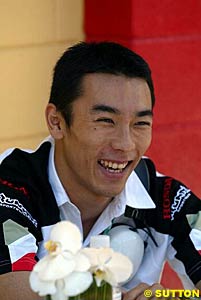 One sign of Honda's long-term intentions is BAR-Honda's Japanese test driver, Takuma Sato. Although Sato had an indifferent year in the 2002 Formula One season driving for Jordan-Honda, his exuberant driving throughout the season and his gritty performance on home ground at Suzuka for the 2002 Japanese Grand Prix where he finished in fifth place was so noisily welcomed by the Japanese crowd that Sato nearly stole the show from winner Michael Schumacher. Plainly, Sato is a diamond in the rough that Honda intends to nurture as part of its grand design for the growth and ultimate ascendancy of BAR-Honda.
One sign of Honda's long-term intentions is BAR-Honda's Japanese test driver, Takuma Sato. Although Sato had an indifferent year in the 2002 Formula One season driving for Jordan-Honda, his exuberant driving throughout the season and his gritty performance on home ground at Suzuka for the 2002 Japanese Grand Prix where he finished in fifth place was so noisily welcomed by the Japanese crowd that Sato nearly stole the show from winner Michael Schumacher. Plainly, Sato is a diamond in the rough that Honda intends to nurture as part of its grand design for the growth and ultimate ascendancy of BAR-Honda.
Please Contact Us for permission to republish this or any other material from Atlas F1.
|
Volume 9, Issue 36
Honda 250: Special Project
Interview with Jacques Villeneuve
Interview with Shoichi Tanaka
Interview with Jenson Button
House of the Rising Sun
Honda's First: Richie Ginther
Honda Through the Lens
Trading Cards: Honda's Drivers
The Honda Trivia Quiz
Columns
On the Road
Elsewhere in Racing
The Weekly Grapevine
> Homepage
By Marcel Schot
1963
1964
1965
1966
1967
1968
1981
1982
1983
1984
1985
1986
1987
1988
1989
1990
1991
1992
1998
1999
2000
2001
2002
2003
|

